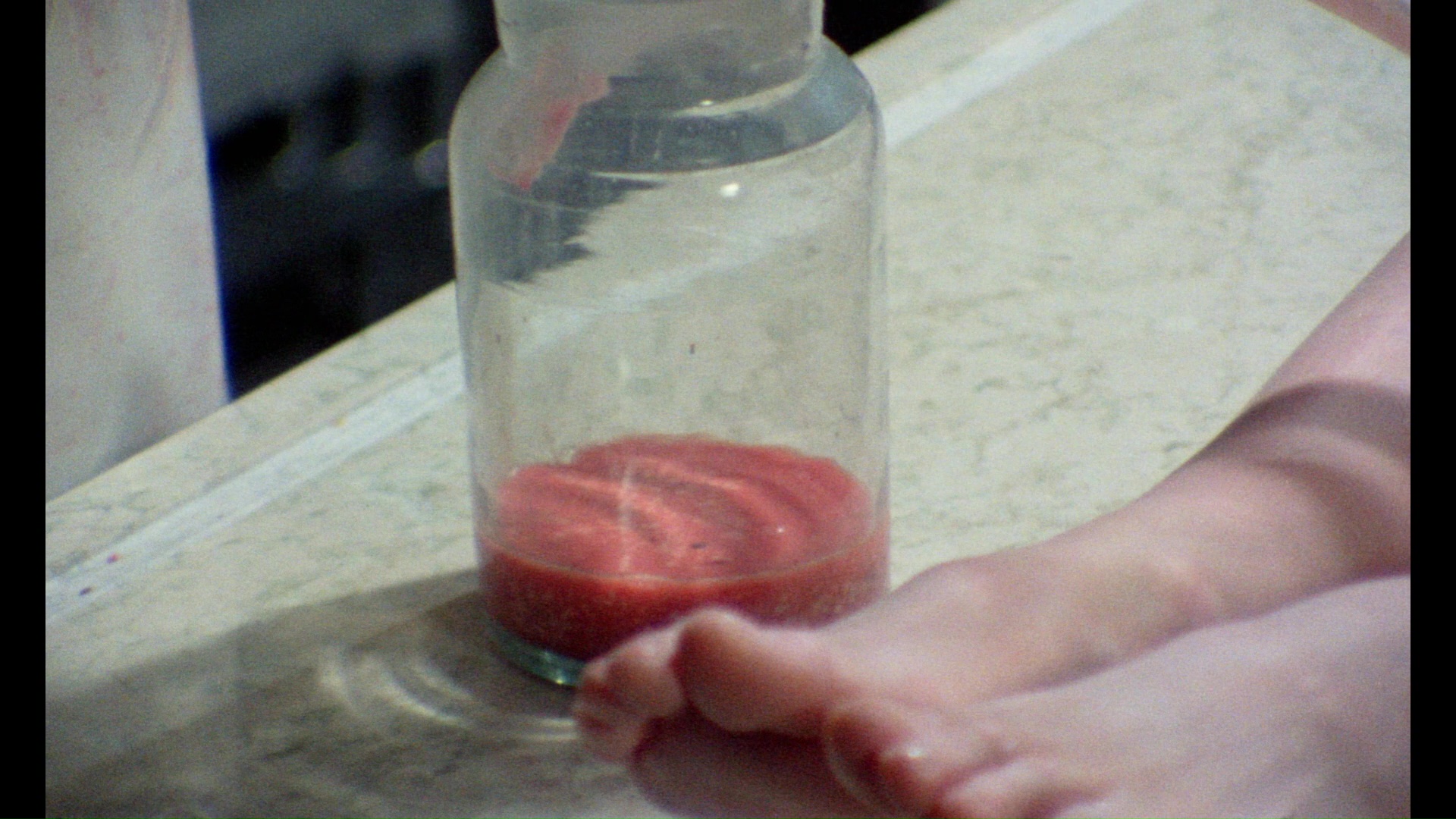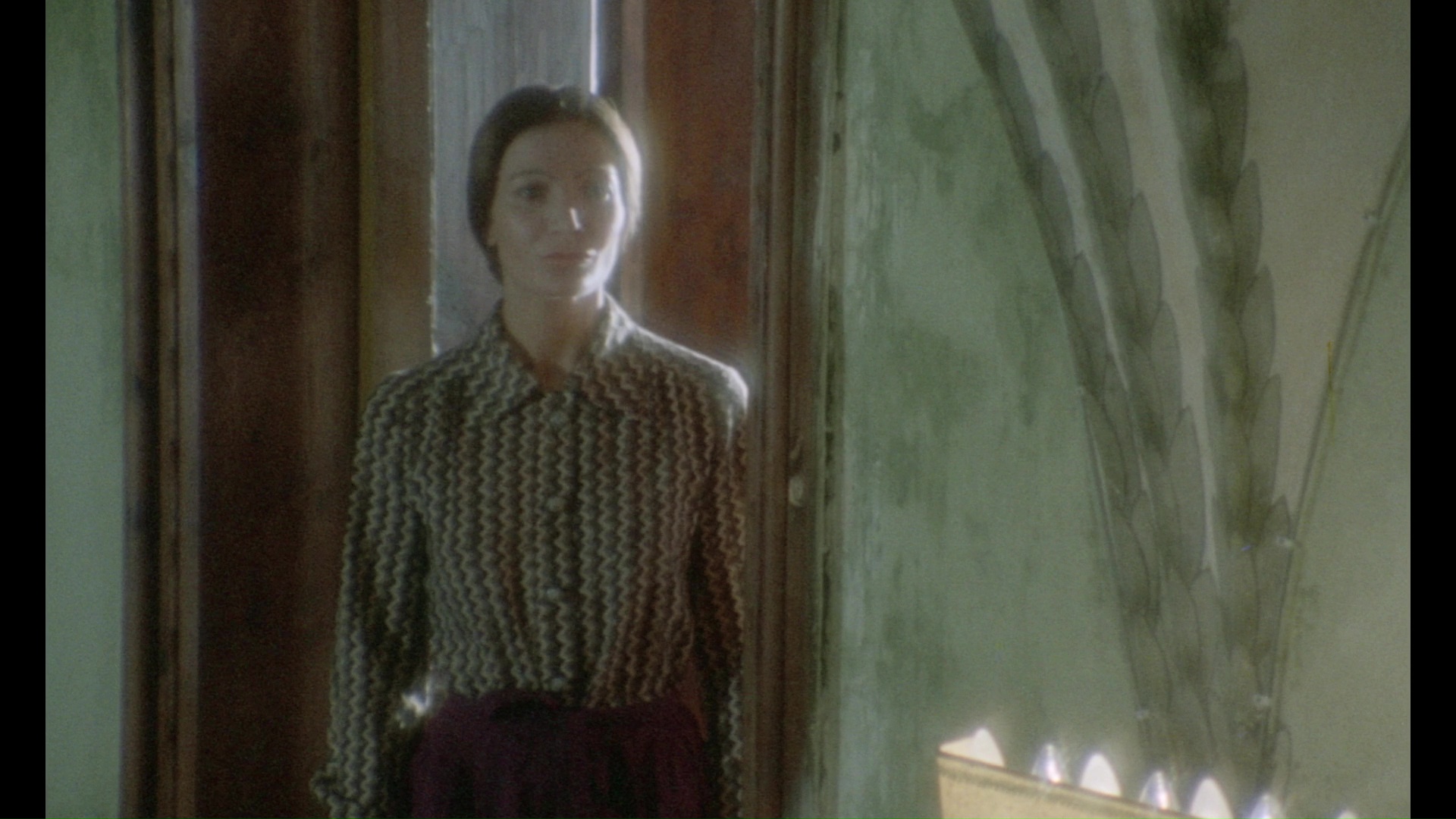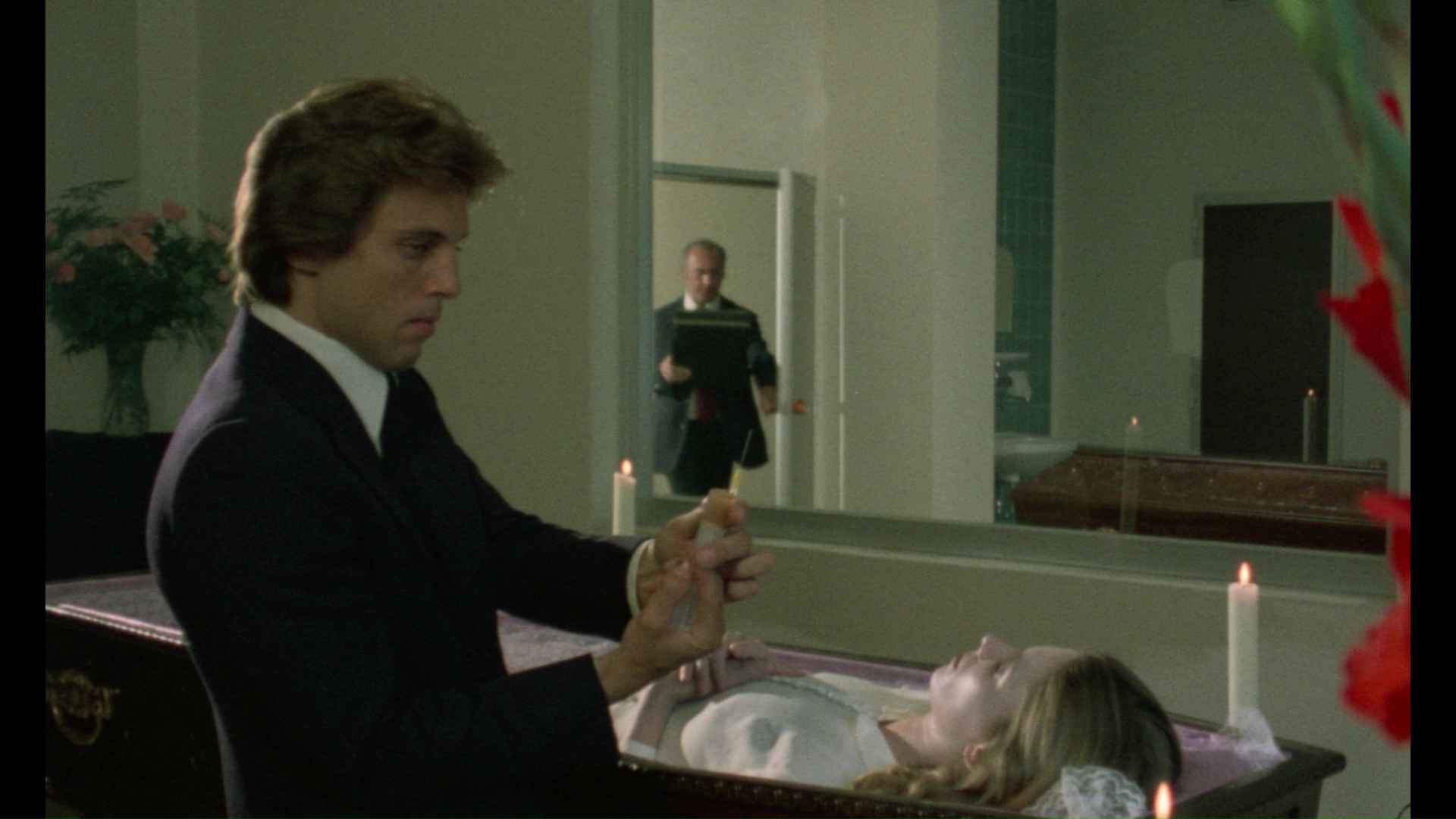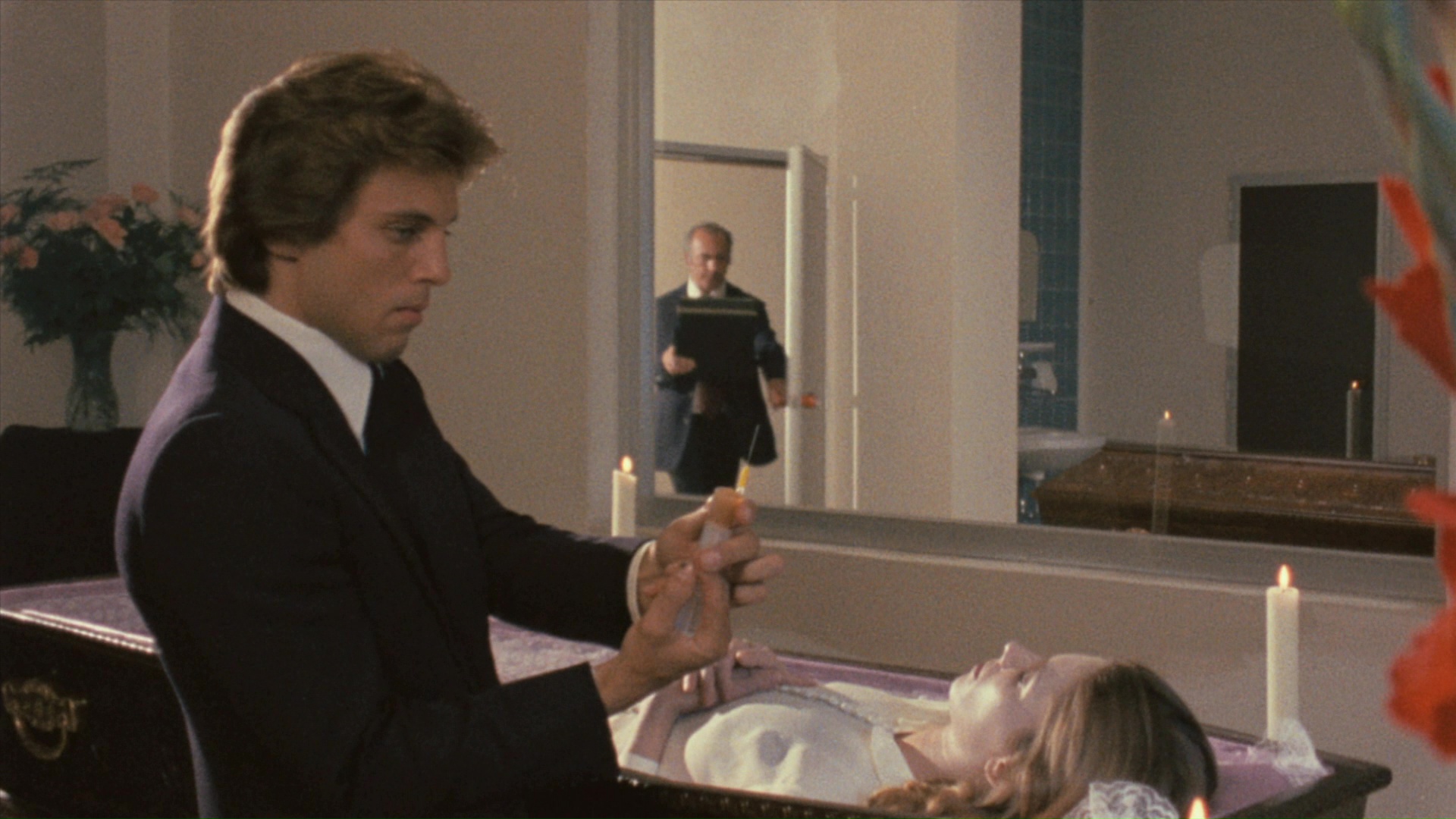

Color, 1979, 94 mins. 18 secs.
Directed by Joe D'Amato
Starring Kieran Canter, Cinzia Monreale, Franca Stoppi, Sam Modesto, Anna Cardini
Severin Films (Blu-ray & DVD) (US R0 HD/NTSC), 88 Films (Blu-ray & DVD) (UK R0 HD/PAL) / WS (1.66:1) (16:9), Media Blasters (Blu-ray & DVD) (US R0 HD/NTSC) / WS (1.85:1) (16:9),


 the hospital. One afternoon news arrives that Anna isn't going to
the hospital. One afternoon news arrives that Anna isn't going to  make it, and Frank barely arrives in time for her to die in his arms. Stricken with grief and losing his grasp on sanity, Frank injects a strong preserving agent in her neck before the funeral and later resorts to digging up Anna's body, disemboweling her in the basement, and preserving her in his bedroom after killing a jogger he's picked up and sinking his teeth into Anna's ripped-out heart. Iris's twisted infatuation with Frank comes to a head as he continues to bring young women home for necrophiliac games, complicated further by the arrival of an unexpected guest and a rapidly escalating body count.
make it, and Frank barely arrives in time for her to die in his arms. Stricken with grief and losing his grasp on sanity, Frank injects a strong preserving agent in her neck before the funeral and later resorts to digging up Anna's body, disemboweling her in the basement, and preserving her in his bedroom after killing a jogger he's picked up and sinking his teeth into Anna's ripped-out heart. Iris's twisted infatuation with Frank comes to a head as he continues to bring young women home for necrophiliac games, complicated further by the arrival of an unexpected guest and a rapidly escalating body count.  (along with Make Them Die Slowly and 7
(along with Make Them Die Slowly and 7  Doors of Death) deemed too extreme or trashy to be introduced by the label's regular hostess, Elvira. It's definitely the kind of film that grabs your attention with a cavalcade of perverse shocks, be it the prolonged and graphic treatment of Anna's corpse, a cringe-inducing bit involving fingernails and a pair of pliers, or Iris's "maternal" comforting of Frank that gives Burial Ground a run for its money. Stoppi gets the showiest role here by far and is perfectly cast, with her severe features and pulled-back hair conveying everything you need to know about her character at first glance. Monreale and Canter are also effective, using their good looks as a counterpoint to the overripe decor and grisly imagery on display, and the effective, pounding score by Goblin (hot on the heels of Dawn of the Dead!) has also played a major role in this film's enduring popularity.
Doors of Death) deemed too extreme or trashy to be introduced by the label's regular hostess, Elvira. It's definitely the kind of film that grabs your attention with a cavalcade of perverse shocks, be it the prolonged and graphic treatment of Anna's corpse, a cringe-inducing bit involving fingernails and a pair of pliers, or Iris's "maternal" comforting of Frank that gives Burial Ground a run for its money. Stoppi gets the showiest role here by far and is perfectly cast, with her severe features and pulled-back hair conveying everything you need to know about her character at first glance. Monreale and Canter are also effective, using their good looks as a counterpoint to the overripe decor and grisly imagery on display, and the effective, pounding score by Goblin (hot on the heels of Dawn of the Dead!) has also played a major role in this film's enduring popularity.  first DVD release in 2002 from Media Blasters were very underwhelming, overmatted at 1.85:1 and interlaced to boot. (It's worth
first DVD release in 2002 from Media Blasters were very underwhelming, overmatted at 1.85:1 and interlaced to boot. (It's worth  noting that some signs of damaged in isolated shots of the film, especially some stain lines visible around the 93-minute mark, are actually baked into the negative and not a transfer issue.) Nine years later, they revisited the film for a Blu-ray release (dual-format with the old DVD included) that didn't set the world on fire. The framing was correctly adjusted to 1.66:1, but the film had a dull, underwhelming appearance hobbled by some indifferent compression and the fact that a transitional scene just after the credits showing Canter transporting the body of a baboon into the house was inexplicably missing. That version clocks in at 93m46s, almost half a minute shorter, with some company production credits tacked at the end to fill out the missing time.
noting that some signs of damaged in isolated shots of the film, especially some stain lines visible around the 93-minute mark, are actually baked into the negative and not a transfer issue.) Nine years later, they revisited the film for a Blu-ray release (dual-format with the old DVD included) that didn't set the world on fire. The framing was correctly adjusted to 1.66:1, but the film had a dull, underwhelming appearance hobbled by some indifferent compression and the fact that a transitional scene just after the credits showing Canter transporting the body of a baboon into the house was inexplicably missing. That version clocks in at 93m46s, almost half a minute shorter, with some company production credits tacked at the end to fill out the missing time.  which
which  is presented with accurate English-translated subtitles. "Omega Rising: Remembering Joe D’Amato" (68m52s) offers a comprehensive overview of his career including a bit of footage with the man himself and lengthy chats with George Eastman, Michele Soavi, composer Carlo Maria Cordio, Claudio Fragasso, and writer Rossella Drudi. It's a big disjointed at times but paints a very warm portrait of the beloved director, a self-described craftsman who had no qualms about any genre he worked in as long as he was still making films.
is presented with accurate English-translated subtitles. "Omega Rising: Remembering Joe D’Amato" (68m52s) offers a comprehensive overview of his career including a bit of footage with the man himself and lengthy chats with George Eastman, Michele Soavi, composer Carlo Maria Cordio, Claudio Fragasso, and writer Rossella Drudi. It's a big disjointed at times but paints a very warm portrait of the beloved director, a self-described craftsman who had no qualms about any genre he worked in as long as he was still making films.  MA
MA  English mono track, while the Italian one is included as lossy Dolby Digital; the latter's status as an afterthought is cemented by the English subtitles, the one area where this release really drops the ball by only including dubtitles for the English version -- and they're SDH, which means they're good for hearing impaired viewers (lots of audio designations like "electronic beeping" and "screams") but essentially useless if you're trying to watch the Italian version. It's subjective which language track is preferable; more often the actors are in synch for the Italian one, but they sound dubbed in both and neither one match up perfectly for a decent amount of the running time, not an uncommon occurrence in Italian genre fims.
English mono track, while the Italian one is included as lossy Dolby Digital; the latter's status as an afterthought is cemented by the English subtitles, the one area where this release really drops the ball by only including dubtitles for the English version -- and they're SDH, which means they're good for hearing impaired viewers (lots of audio designations like "electronic beeping" and "screams") but essentially useless if you're trying to watch the Italian version. It's subjective which language track is preferable; more often the actors are in synch for the Italian one, but they sound dubbed in both and neither one match up perfectly for a decent amount of the running time, not an uncommon occurrence in Italian genre fims.  occasional interview snippets, resulting in an avalanche of anecdotes from everyone involved about animal guts, gambling, deflowering someone in a swimming pool, and lots more. (You'll probably be shocked by the film
occasional interview snippets, resulting in an avalanche of anecdotes from everyone involved about animal guts, gambling, deflowering someone in a swimming pool, and lots more. (You'll probably be shocked by the film  he cites as the best he ever made, too.) Stoppi appears next in "The Omega Woman" (15m41), cheerfully recalling having to dye her hair for the film, kicking her leading man in the crotch, and sitting incognito among a crowd watching the film in a theater, while Monreale appears for "Sick Love" (8m47s), recalling her fondness for D'Amato, the lack of discomfort with the disembowelment scene, and the makeup trickery that made her appear dead on camera. Both of these are Freak-o-Rama featurettes and quite entertaining -- and between them you also learn that both actresses had some romantic involvement with Canter either before or after the production, which is odd to bear in mind when you watch the actual film. It's a shame no one has been able to snag an interview yet with Canter himself; after this he moved on to a few soft and hardcore films (including the crazed L'amante bisex) and even the Pia Zadora vehicle The Lonely Lady before embarking on a current school bus coordinator career in Rome. That's a story that just has to be captured one of these days. Goblin Reborn, one of the two iterations of the legendary band currently touring the world, can also be seen performing the film's theme live (4m17s) in 2016, and "Locations Revisited" and the English trailer are included as well. The Blu-ray edition also comes with a bonus CD soundtrack, the remastered 24-track version reissued in Italy versus the original 15-track one from Cinevox (which had the stereo channels reversed).
he cites as the best he ever made, too.) Stoppi appears next in "The Omega Woman" (15m41), cheerfully recalling having to dye her hair for the film, kicking her leading man in the crotch, and sitting incognito among a crowd watching the film in a theater, while Monreale appears for "Sick Love" (8m47s), recalling her fondness for D'Amato, the lack of discomfort with the disembowelment scene, and the makeup trickery that made her appear dead on camera. Both of these are Freak-o-Rama featurettes and quite entertaining -- and between them you also learn that both actresses had some romantic involvement with Canter either before or after the production, which is odd to bear in mind when you watch the actual film. It's a shame no one has been able to snag an interview yet with Canter himself; after this he moved on to a few soft and hardcore films (including the crazed L'amante bisex) and even the Pia Zadora vehicle The Lonely Lady before embarking on a current school bus coordinator career in Rome. That's a story that just has to be captured one of these days. Goblin Reborn, one of the two iterations of the legendary band currently touring the world, can also be seen performing the film's theme live (4m17s) in 2016, and "Locations Revisited" and the English trailer are included as well. The Blu-ray edition also comes with a bonus CD soundtrack, the remastered 24-track version reissued in Italy versus the original 15-track one from Cinevox (which had the stereo channels reversed). 








